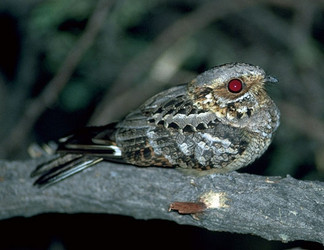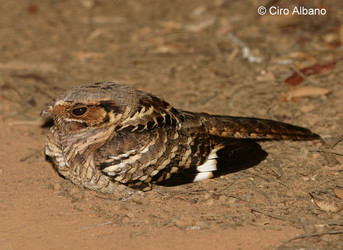Caprimulgidae
Nightjars



This tree diagram shows the relationships between several groups of organisms.
The root of the current tree connects the organisms featured in this tree to their containing group and the rest of the Tree of Life. The basal branching point in the tree represents the ancestor of the other groups in the tree. This ancestor diversified over time into several descendent subgroups, which are represented as internal nodes and terminal taxa to the right.

You can click on the root to travel down the Tree of Life all the way to the root of all Life, and you can click on the names of descendent subgroups to travel up the Tree of Life all the way to individual species.
For more information on ToL tree formatting, please see Interpreting the Tree or Classification. To learn more about phylogenetic trees, please visit our Phylogenetic Biology pages.
close boxRelationships after Barrowclough et al. 2006 and Larsen et al. 2007.
References
Barrowclough, G. F., J. G. Groth and L. A. Mertz. 2006. The RAG-1 exon in the avian order Caprimulgiformes: Phylogeny, heterozygosity, and base composition. Molecular Phylogenetics and Evolution 41:238-248.
Cleere, N. 1998. Nightjars: A Guide to the Nightjars, Nighthawks, and Their Relatives. Yale University Press, Princeton, New Jersey.
Larsen, C., M. Speed, N. Harvey and H. A. Noyes. 2007. A molecular phylogeny of the nightjars (Aves: Caprimulgidae) suggests extensive conservation of primitive morphological traits across multiple lineages. Molecular Phylogenetics and Evolution 42:789-796.
Mariaux, J. and M. J. Braun. 1996. A molecular phylogenetic survey of the nightjars and allies (Caprimulgiformes) with special emphasis on the potoos (Nyctibiidae). Molecular Phylogenetics and Evolution 6(2):228-244.
Title Illustrations

| Scientific Name | Caprimulgus pectoralis |
|---|---|
| Location | Okavango Delta, Botswana |
| Comments | Fierynecked Nightjar |
| Specimen Condition | Live Specimen |
| Behavior | on low branch after nightfall |
| Copyright |
© 1990 Greg and Marybeth Dimijian

|
| Scientific Name | Nyctidromus albicollis |
|---|---|
| Location | Chapada do Araripe - CE, Brazil |
| Specimen Condition | Live Specimen |
| Source | Curiango - Nyctidromus albicollis - Pauraque |
| Source Collection | Flickr |
| Copyright |
© 2005 Ciro Albano

|
About This Page
Page copyright © 2007
 Page: Tree of Life
Caprimulgidae. Nightjars.
The TEXT of this page is licensed under the
Creative Commons Attribution-NonCommercial License - Version 3.0. Note that images and other media
featured on this page are each governed by their own license, and they may or may not be available
for reuse. Click on an image or a media link to access the media data window, which provides the
relevant licensing information. For the general terms and conditions of ToL material reuse and
redistribution, please see the Tree of Life Copyright
Policies.
Page: Tree of Life
Caprimulgidae. Nightjars.
The TEXT of this page is licensed under the
Creative Commons Attribution-NonCommercial License - Version 3.0. Note that images and other media
featured on this page are each governed by their own license, and they may or may not be available
for reuse. Click on an image or a media link to access the media data window, which provides the
relevant licensing information. For the general terms and conditions of ToL material reuse and
redistribution, please see the Tree of Life Copyright
Policies.
- First online 04 June 2007
- Content changed 04 June 2007
Citing this page:
Tree of Life Web Project. 2007. Caprimulgidae. Nightjars. Version 04 June 2007 (temporary). http://tolweb.org/Caprimulgidae/26398/2007.06.04 in The Tree of Life Web Project, http://tolweb.org/









 Go to quick links
Go to quick search
Go to navigation for this section of the ToL site
Go to detailed links for the ToL site
Go to quick links
Go to quick search
Go to navigation for this section of the ToL site
Go to detailed links for the ToL site